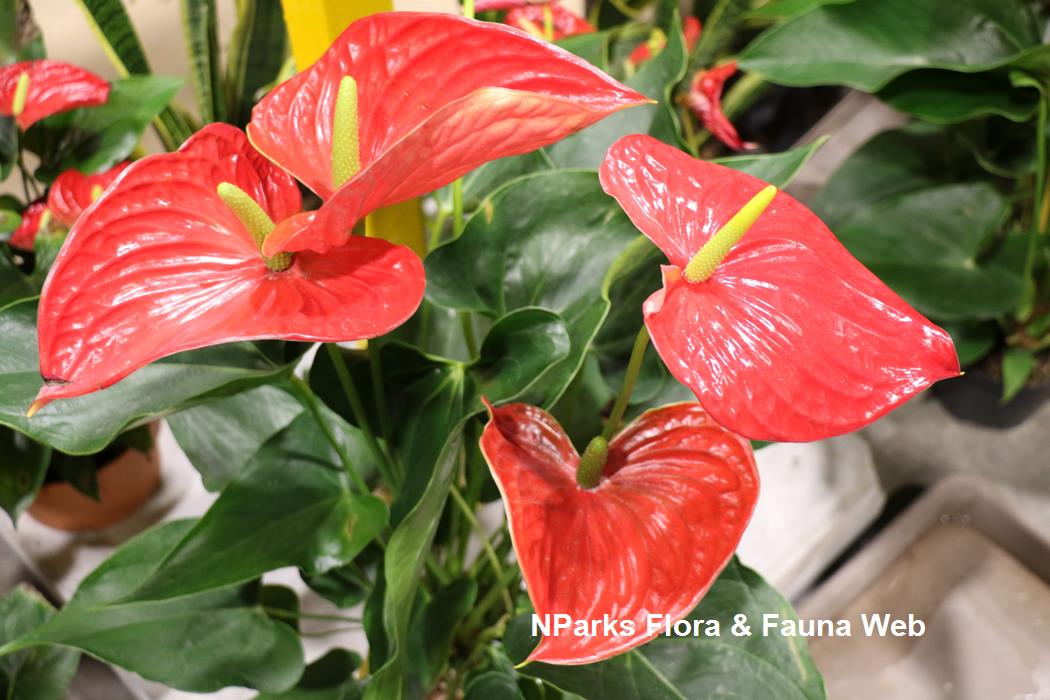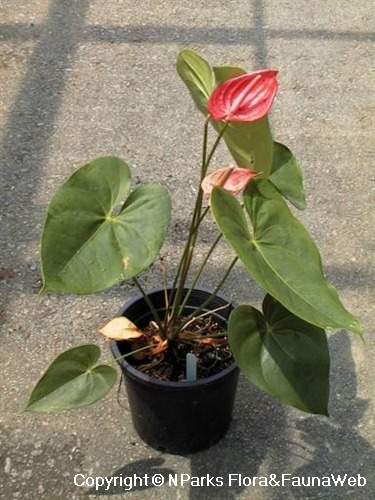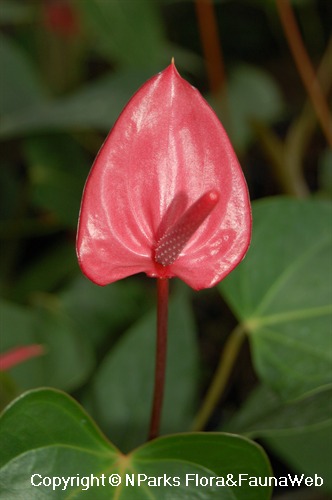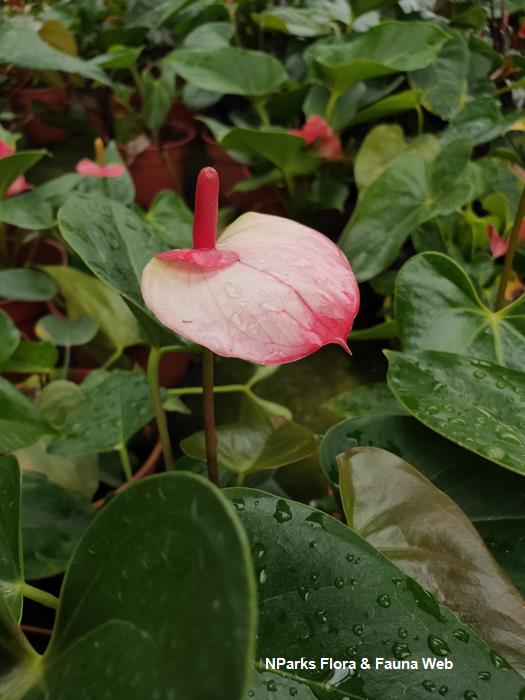
Back
Anthurium andraeanum Linden ex André
| Family Name: | Araceae |
| Synonyms: | Anthurium venustum Sodiro |
| Common Name: | Flamingo Lily, Painter's Palette, Flamingo Flower, Anthurium, Tailflower, 红掌, 火鹤花 |
Anthurium andraeanum or Flamingo Lily is a herbaceous evergreen plant that grows to 40 cm in height. The dark green leaves are heart-shaped and glossy. The inflorescence is made up of a cream yellow tail-like spadix and waxy red spathe. Coupled with frequent blooming and tolerance to partial shade, it is cultivated to produce various colours and sizes of spathe, making Flamingo Lily a popular houseplant.
Name
Classifications and Characteristics
| Plant Division | Angiosperms (Flowering Seed Plants) (Monocotyledon) |
|---|---|
| Plant Growth Form | Herbaceous Plant |
| Lifespan (in Singapore) | Perennial |
| Mode of Nutrition | Autotrophic |
| Plant Shape | Open |
| Maximum Height | 0.4 |
Biogeography
| Native Distribution | Colombia, Ecuador |
|---|---|
| Native Habitat | Terrestrial |
| Preferred Climate Zone | Tropical |
| Local Conservation Status | Non-native |
Description and Ethnobotany
| Growth Form | It is an small, upright herbaceous plant that grows to 40 cm in height. Adventitious roots may occur in some plants. |
|---|---|
| Foliage | Its foliage are heart-shaped, glossy with a smooth leaf margin. The dark green leaves can measure up to 20 cm long. |
| Flowers | Its flowers are axillary, produced on a spadix inflorescence. The inflorescence comprise of a cream-yellow tail-like spadix and bright red spathe that is wide, flat and waxy. The long lasting flowers can bloom multiple times yearly when optimum conditions are met. |
| Fruit | Its fruits are small, round, yellow in colour produced along the spadix. Fruits are rarely observed on indoor plants. |
| Cultivation | Anthurium grows well in moist, well-drained soil. Locations which are window-facing can promote better blooms and faster growth. Wipe the foliage periodically to remove dust. |
| Etymology | The genus Anthurium means flower-tail, which refers to the tail-like spadix. The specific epithet andraeanum is named after Edouard F. Andre (1840-1911), a French botanist and horticultural editor. |
| Ethnobotanical Uses | Cut - Dried Flower: Cut flowers |
Landscaping Features
| Desirable Plant Features | Ornamental Flowers, Ornamental Foliage |
|---|---|
| Landscape Uses | Interiorscape/ Indoor Plant, Container Planting |
Plant Care and Propagation
| Light Preference | Semi-Shade |
|---|---|
| Water Preference | Moderate Water |
| Plant Growth Rate | Fast |
| Rootzone Tolerance | Well-Drained Soils, Moist Soils |
| Propagation Method | Division |
Foliar
| Foliage Retention | Evergreen |
|---|---|
| Mature Foliage Colour(s) | Green |
| Mature Foliage Texture(s) | Glossy / Shiny |
| Foliar Type | Simple / Unifoliate |
| Foliar Arrangement Along Stem | Alternate |
| Foliar Attachment to Stem | Petiolate |
| Foliar Shape(s) | |
| Foliar Venation | Pinnate / Net |
| Foliar Margin | Entire |
| Foliar Apex - Tip | Cuspidate |
| Foliar Base | Cordate |
| Leaf Area Index (LAI) for Green Plot Ratio | 3.5 (Shrub & Groundcover - Monocot) |
Non - Foliar and Storage
| Stem Type & Modification | Herbaceous |
|---|---|
| Root Type | Underground (Fibrous Root) |
Floral (Angiosperm)
| Flower & Plant Sexuality | Bisexual Flowers , Bisexual Flowers |
| Flower Colour(s) | Red |
|---|
| Flower Texture(s) | Waxy |
| Flower Grouping | Cluster / Inflorescence |
| Flower Location | Axillary |
| Individual Flower Shape | Cruciform / Cross-shaped |
| Inflorescence Type | Spathe & Spadix |
| Flowering Period | Free-Flowering |
| Flowering Habit | Polycarpic |
Fruit, Seed and Spore
| Mature Fruit Colour(s) | Yellow / Golden |
|---|---|
| Fruit Classification | Simple Fruit |
| Fruit Type | Fleshy Fruit , Fleshy Fruit |
References
| References | Higaki, T., Rasmussen, H.P, Carpenter, W.J. (1984). A study of some morphological and anatomical aspects of Anthurium andreanum Lind. Hitahr Research Series. 30: 1 - 12. North Carolina Extension Gardener Plant Toolbox. North Carolina State University. https://plants.ces.ncsu.edu/plants/anthurium/. Accessed 17 December 2021. Plant Finder (continuously updated). Missouri Botanical Garden. https://www.missouribotanicalgarden.org/PlantFinder/PlantFinderDetails.aspx?kempercode=b575. Accessed 17 December 2021. Royal Botanic Gardens, Kew (continuously updated). Plants of the World Online | Kew Science. https://powo.science.kew.org/taxon/urn:lsid:ipni.org:names:84549-1. Accessed 17 December 2021. |
|---|
Image Repository
Others
| Master ID | 376 |
|---|---|
| Species ID | 1672 |
| Flora Disclaimer | The information in this website has been compiled from reliable sources, such as reference works on medicinal plants. It is not a substitute for medical advice or treatment and NParks does not purport to provide any medical advice. Readers should always consult his/her physician before using or consuming a plant for medicinal purposes. |






.jpg)

